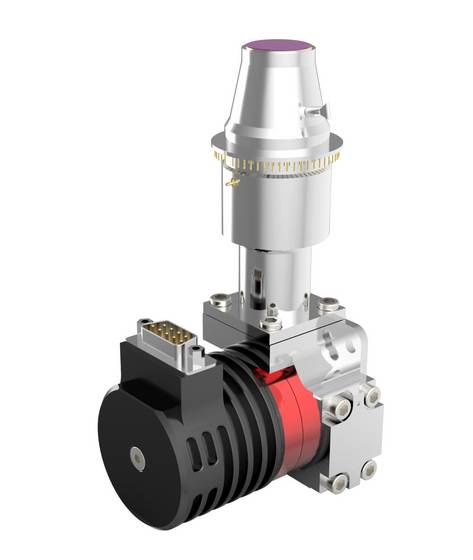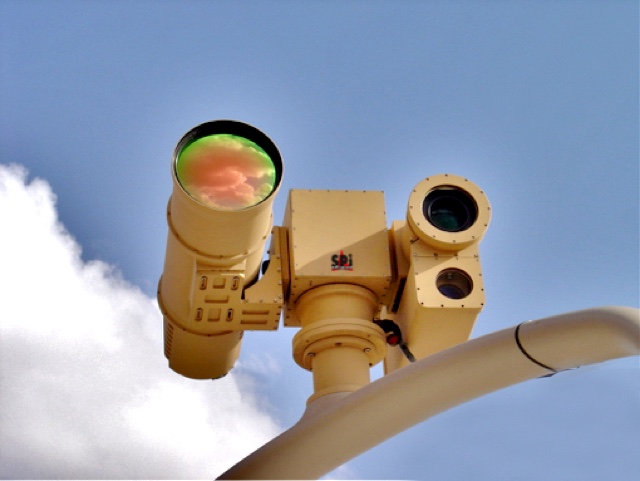Cooled thermal camera systems are the clear choice for long range imaging. This is due to the highly sensitive FPA technology they employ. Typically, a cooled thermal camera will utilize either InSb or MCT sensor materials. These are very good materials for a thermal array in the 3-5 micron range. However, Focal Plane Arrays made from these materials do require cryogenic cooling in order to function at their peak performance level. That is why they are called “cooled thermal camera” systems. But, when these exotic sensor materials are combined with an appropriate cooling system, the result is a thermal imaging system that boasts MRTD’s on the order of 20mk or less. In practical terms this equates to 3-4 times the sensitivity of uncooled thermal camera systems. The sensitivity of cooled sensors, allows us to use much smaller lenses (f/4-f/5.5). It follows that, given a certain envelope of space, we can fit a much longer focal length lens into a cooled thermal camera design than any other technology would allow. When ultimate distance matters, long range cooled thermal camera systems are the only option.

Cooled Thermal Camera Sensor Types
Exotic materials are used to produce the focal plane array sensors that are used in cooled thermal cameras. The most common are Indium Antimonide (InSb) and Mercury Cadmium Telluride (HgCdTe).
InSb
The InSb (commonly referred to as Ins-Bee or reticulated insb) sensor material is a narrow gap semiconductor in crystaline form. It is sensitive to wavelengths of 1µm to 5µm but is typically filtered, in cooled thermal camera systems, to 3µm to 5µm. InSb detectors have long been the leading choice for imaging systems that feature long range thermal optics. It is a reliable and mature sensor technology that is manufactured in various countries around the world. The InSb detector does require cryogenic cooling to operate at peak efficiency and produce a usable thermal image. In the past ,this was accomplished by a dewar that needed to be filled with Liquid Nitrogen. The dewars are long gone. Now,highly efficient cryo coolers manage the task of cooling down to ~80°K.
The M9 Cooled MWIR Camera System uses InSb Detectors and is the pinnacle of cooled Long Range thermal camera systems, The Unit has extremely long range cooled MWIR lenses which
provides Very long range detection Ranges up to 60 Kilometers
HgCdTe
The HgCdTe (commonly referred to as MCT or Mer-Cad) sensor material is a narrow direct bandgap zincblende. MCT sensors are tuned to operate in wavelengths from 1µm all the way to 14µm. They are a versatile sensor material. Unlike InSb sensors, MCT sensors produce cooled thermal camera systems that access both atmospheric transmission windows of 3µm to 5µm and 7µm to 14µm. Most people think of cooled cameras as always being MWIR (3µm-5µm). MCT materials produce a cooled thermal camera that is MWIR or LWIR (7µm to 14µm). MCT focal plane arrays also require cryogenic cooling to ~80°K.
HOT HgCdTe (The New Kid On The Block)
Hot MCT is a relatively new technology utilizing Mer Cad based sensors. The new “HOT” sensors operate at warmer temperatures than the InSb and traditional HgCdTe chips. Instead of cooling to 80°K the HOT MCT only needs to be cooled to 160°K. In practical terms this greatly reduces the load on the cryo cooler. This creates a cooled thermal camera that starts up faster, has a longer cooler lifespan and uses less power. This is fantastic for SWaP efforts. The Hot MCT is a new development that is very promising but only time will tell if it proves to be the future of cooled thermal.

In conclusion, cooled thermal camera systems incorporate different sensor materials but offer distinct advantages when used in long range and ultra long range thermal imaging platforms. The key is the increased sensitivity and smaller lens sizes. Next time, we will discuss lens options for your cooled thermal camera.

SPI long range cooled MWIR thermal camera with laser range finder-SPI
UP NEXT COOLED THERMAL CAMERA LENSES >>>
Examples of systems using the above technology. This is only a partial list of whats possible with cooled thermal imaging. Review the site for more options or contact us to discuss thermal imaging. Thats what we do here. Make sure you tune in next time for a complete review of lens and optical systems for long range thermal camera systems.
- M9 cooled thermal camera long range platform
- 3-5µm MWIR cooled FLIR camera module
- Panoramic cooled MWIR 360 persistent surveillance thermal camera
- MILCAM long range handheld FLIR cooled thermal camera
- FLIR thermacam cooled camera PDM

cooled thermal image of a plane

